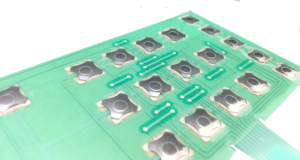Just How Membrane Layer Switches Contribute to the Toughness of Electronic Control Panels
Membrane switches play a vital duty in improving the durability of digital control panels, largely through their multi-layered construction which supplies effective security against ecological aspects such as dampness and dirt. The lack of moving parts substantially decreases the likelihood of mechanical failures, making membrane layer changes suitable for demanding applications.
Interpretation of Membrane Layer Buttons

Membrane switches are made to be slim and lightweight, making them suitable for applications where space is limited. They can be produced in different shapes, dimensions, and colors, using flexibility in design that meets visual and practical requirements. Additionally, membrane switches can integrate various technologies, such as tactile feedback and LED signs, boosting user experience.
As a result of their construction, membrane layer buttons are typically immune to dirt, moisture, and basic wear, adding to their durability in demanding environments. Their seamless layout not just helps with easy cleaning but also minimizes the risk of mechanical failing, making them a favored option for producers seeking dependable user interfaces in their electronic control board.
Protection Against Ecological Variables
The design of membrane changes inherently offers a degree of security against different environmental variables, which is crucial for preserving functionality in tough conditions - Membrane Switch. These switches are normally constructed with layers of adaptable materials that secure internal elements from wetness, dirt, and contaminants. By enveloping the circuitry, membrane layer changes reduce the danger of brief circuits and deterioration, which can dramatically impair efficiency
Furthermore, making use of durable adhesives and sealants during production enhances their resistance to environmental challenges. Membrane switches can withstand exposure to chemicals and solvents, making them ideal for sectors such as food handling and health care, where health and sanitation are vital. Their seamless surface style additionally avoids the buildup of dust and microorganisms, facilitating less complicated cleansing and maintenance.
Temperature fluctuations are an additional ecological worry, and membrane buttons are engineered to work effectively throughout a large range of temperature levels (Membrane Switch). This versatility makes certain that control panels continue to be operational in different setups, from industrial atmospheres to consumer electronics
Influence On User Interaction
Individual interaction with digital control board is significantly affected by the layout and performance of membrane layer switches. These switches supply a responsive interface that boosts the overall individual a fantastic read experience, permitting for user-friendly navigating and control. Their responsive nature makes sure that customers receive instant comments upon activation, which is vital for tasks needing accuracy and efficiency.
In addition, the smooth surface area of membrane layer switches facilitates easy cleaning and upkeep, promoting user confidence in the reliability of the interface. This tidiness is especially vital in atmospheres where hygiene is critical, such as clinical or food processing setups. Furthermore, the compact and lightweight design of membrane changes adds to the aesthetic charm of control board, urging individual engagement via a modern and smooth look.
In addition, the integration of visual elements, such as printed icons and backlighting, helps customers swiftly recognize features, lowering pop over here the discovering contour related to brand-new devices. Consequently, users can operate gadgets better, leading to increased performance and contentment. In summary, membrane switches play a critical duty in improving individual communication by combining performance, aesthetics, and simplicity of use, inevitably bring about enhanced functional efficiency.
Layout Adaptability and Customization
Style flexibility and modification are crucial aspects of membrane layer switches, making it possible for manufacturers to tailor digital control panels to certain applications and individual needs. This adaptability permits the assimilation of different layout components, such as shades, graphics, and appearances, which can enhance the visual allure and individual involvement of the control panel.
Membrane layer switches can be customized in shapes and size, fitting a large range of gadgets and applications, from commercial equipment to customer electronics. This versatility guarantees that suppliers can develop user-friendly interfaces that straighten with individual expectations and functional requirements. Furthermore, the capability to integrate distinct functions such as backlighting or responsive responses better improves use, enabling a much more interactive experience.
Moreover, the manufacturing procedure for membrane layer switches supports the quick prototyping of styles, enabling suppliers to iterate and fine-tune their principles quickly. This ability not just increases the growth timeline yet additionally ensures that the end product fulfills specific useful and visual requirements.

Cost-Effectiveness and Longevity
Cost-effectiveness and durability are substantial advantages of membrane layer switches, making them an appealing alternative for manufacturers and end-users alike. These switches are usually less costly to produce than typical mechanical switches, largely as a result of their simplified manufacturing procedures and the reduced number of components required. This expense advantage extends not just to preliminary manufacturing but also to long-lasting functional costs, as membrane buttons commonly call for much less upkeep and have a reduced failing price.
Moreover, the longevity of membrane layer switches over adds to their total worth. Created from durable materials, they are immune to ecological elements such as moisture, dust, and chemicals, which can lead to premature wear in other switch kinds. The lack of relocating components lessens mechanical failing, enabling membrane switches over to maintain performance over prolonged periods.
This toughness is especially useful in applications needing regular efficiency under demanding problems, such as clinical gadgets and commercial equipment. Eventually, the mix of cost-effectiveness and long i was reading this life makes membrane changes an economically practical choice for manufacturers, supplying trustworthy options that withstand the examination of time while optimizing monetary factors to consider.
Verdict
To conclude, membrane switches considerably improve the resilience of electronic control panels with their durable construction and safety functions. By effectively securing wiring from ecological threats and decreasing the risk of mechanical failing, these switches make certain regular efficiency popular applications. The smooth design advertises hygiene and simplicity of maintenance, while customization choices enable tailored solutions for different needs. Generally, membrane layer switches over represent a reliable and cost-effective selection for improving the longevity and capability of electronic control systems.